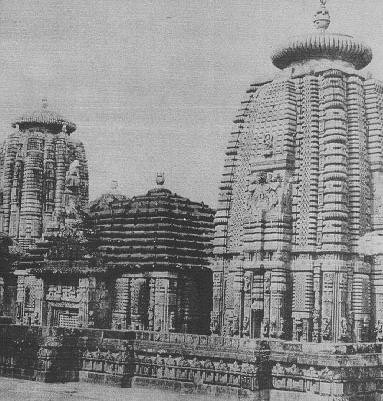
Much needs to be said about the temples of Orissa. The Golden triangle of Orissa comprising Bhubaneswar, Puri and Konark attracts tourists from around the world. There are hundreds of lesser known temples in Orissa. The city of Bhubaneswar abounds in temples built over a range of several centuries.
The temples of Orissa exhibit a majestic grandeur. An Orissan temple (deul) usually consists of a sanctum, one or several front porches (jagamohana) usually with pyramidal roofs, a dancing hall (nata mandir) and a hall of offerings (bhog mandir). The Lingaraj temple at Bhubaneswar boasts of a 150 foot high deul while the Janannath Temple at Puri is about 200 feet high and it dominates the skyline of the town. Only a portion of the Sun Temple at Konark, the largest of the temples of the Golden triangle exists today, and it is still staggering in size. It stands out as a masterpiece in Orissan architecture.
Orissa's history dates back to the days of the Mahabharata. It was under the rule of the Nanda Kings in the pre Christian era and then under the Mauryan rule. Rock edicts of Emperor Ashoka are found in the State. The impact of the invasion of the Guptas is seen in the early temples of Bhubaneswar. The Matharas ruled Orissa from the later half of the 4th century AD. The Sailodbhavas who followed constucted several shrines the ruins of which can be seen today. (600-750 AD).
The period of the Bhaumakaras and Somavamsis (8tth to 11th centuries AD) played a major role in the cultural life of the State. Saivism dominated the religious scene although Budhist, Jain and Vaishnavite monuments also came into being. The Gangas took over after the decline of the Somavamsis. The early Eastern Gangas ruled from Kalinganagara (Mukhalingam near Srikakulam Andhrapradesh). They shifted their capital to Cuttack in the 12th century. Saivism began to decline while Saktism flourished. Further, the religious leader Ramanujacharya had a great influence on the monarch Chodagangadeva who built the great temple at Puri. The Gangas were champions of Vaishnavism. It was during the Ganga rule that Orissan architecture reached its peak. Narasimhadeva of this dynasty built the Sun Temple at Konark.
The Gangas were succeeded by the Suryavamsi Gajapati rulers, under whom Vaishnavism in the form of Jagannatha worship reached new heights. This period was marked by the influence of Chaitanya Mahaprabhu and by the construction of Jagannatha temples across the length and breadth of the empire. After the decline of the Gajapatis, the kingdom began to disintegrate and was taken over by followed by Muslim rule, the rule of the Mughals, the Mahrattas and then the British. The Bhoi Gajapatis who ruled Orissa over a small territory caused several Jagannatha temples to come up.

